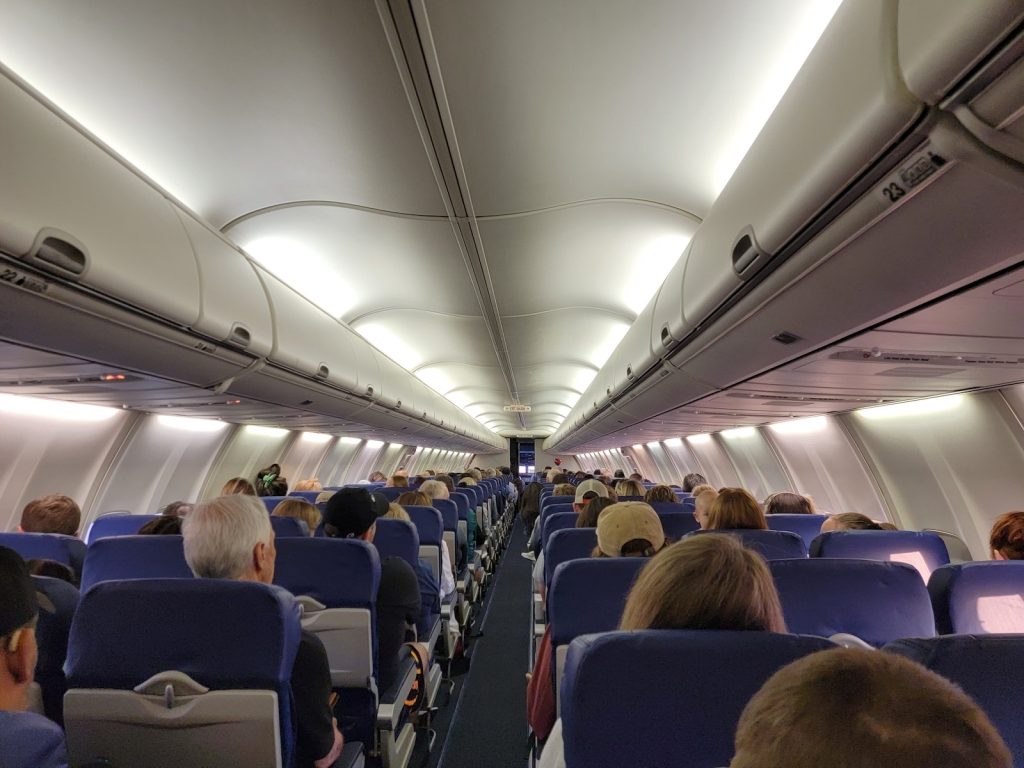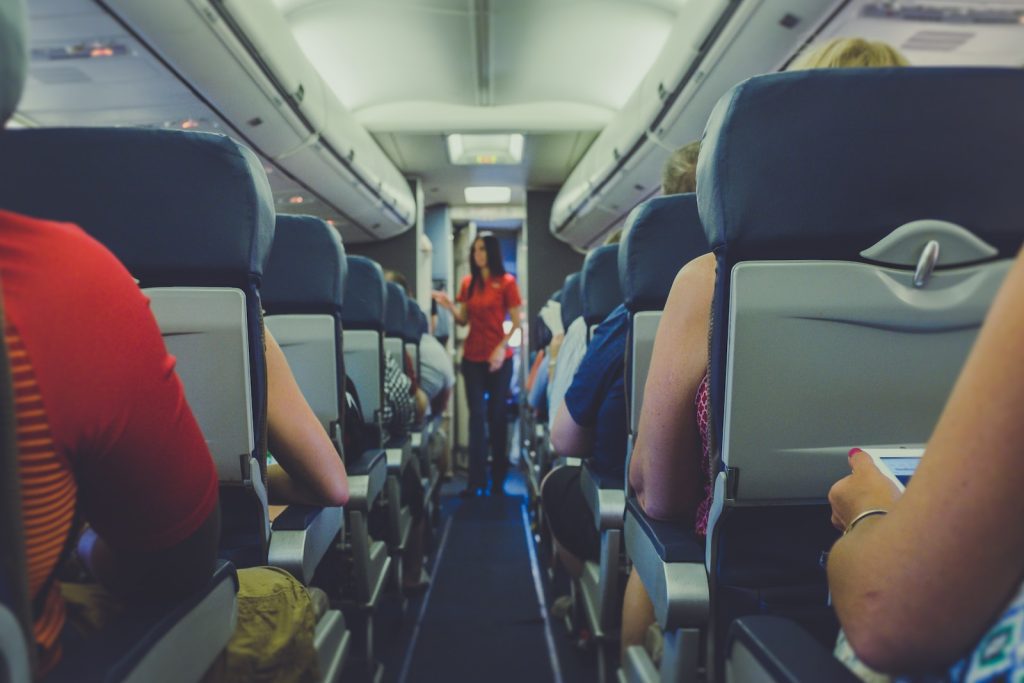Many people wonder whether they can charge their phone on a plane. The answer is yes, but it depends on the airline and the type of plane you are flying on. Some planes have power outlets in every seat, while others only have them near certain seats. If your upcoming flight does not have an outlet, you should still be able to charge your phone on the plane using a portable charger or power bank.
According to TSA guidelines, portable chargers or power banks must only be packed in your carry-on bags instead of your checked bags. This is because they contain lithium-ion batteries, which can pose a fire risk when they are damaged or short-circuited. It is important to note that the capacity of your power bank may be limited by the airline, so it is best to check with them before you fly.
There are also other ways to charge your phone on a plane, such as using USB ports or in-flight entertainment systems. However, it is important to be aware of the restrictions and limitations of each method. By understanding the different options available, you can ensure that your phone stays charged during your flight.

Can You Charge Your Phone on a Plane
Many people wonder if it is possible to charge their electronic devices, such as smartphones, laptops, and tablets, while on a plane. The answer is yes, but there are some important things to keep in mind.
Firstly, it is important to note that not all planes have charging ports available. Some airlines, such as American Airlines and Delta Airlines, do offer power outlets for passengers to charge their devices, but this is not always the case. It is best to check with the airline beforehand to see if charging ports are available on the specific flight.
If charging ports are available, passengers should also be aware of the type of outlet available. Some planes may only have DC power outlets, which require an AC to DC adapter to charge devices. It is important to ensure that any portable battery or power bank brought on the plane complies with TSA regulations, which limit lithium-ion batteries to a maximum of 100 watt-hours.
Passengers should also be aware of the rules regarding electronic devices on planes. Devices should be turned off or put in airplane mode during takeoff and landing. Additionally, there are fines for attempting to charge devices while they are turned on during these times.
In-seat power is another option for charging electronic devices. Some planes have power outlets located in the seats themselves, allowing passengers to charge their devices without the need for an adapter. Again, it is important to check with the airline beforehand to see if in-seat power is available on the specific flight.
Overall, while it is possible to charge electronic devices on a plane, it is important to be aware of the specific rules and regulations in place. Checking with the airline beforehand and ensuring that any devices or batteries brought on the plane comply with regulations can help make the charging process smoother and easier.
Airline Policies
When it comes to charging your phone on a plane, it’s important to know the policies of the airline you’re flying with. While many airlines offer power outlets and USB ports in some seats, not all do. Here is a breakdown of the policies of several major airlines:
American Airlines
American Airlines offers power outlets on the majority of their planes, so you should be able to charge your phone on most flights. However, it’s always a good idea to bring a portable charger just in case.
United Airlines
United Airlines also offers power outlets on most of their planes, but they may not be available in all seats. It’s a good idea to check with the airline before your flight to see if your seat will have a power outlet.
Alaska Airlines
Alaska Airlines offers power outlets and USB ports on most of their planes, so you should be able to charge your phone on most flights.
Delta Airlines
Delta Airlines offers power outlets on most of their planes, but there may be some planes or seats that don’t have them. It’s always a good idea to bring a portable charger just in case.
Southwest Airlines
Southwest Airlines does not offer power outlets on their planes, so you will need to bring a portable charger if you want to charge your phone during the flight.
Jetblue
Jetblue offers power outlets and USB ports on most of their planes, so you should be able to charge your phone on most flights.
Allegiant Air
Allegiant Air does not offer power outlets on their planes, so you will need to bring a portable charger if you want to charge your phone during the flight.
Frontier Airlines
Frontier Airlines offers power outlets on some of their planes, but they may not be available in all seats. It’s a good idea to check with the airline before your flight to see if your seat will have a power outlet.
Spirit Airlines
Spirit Airlines does not offer power outlets on their planes, so you will need to bring a portable charger if you want to charge your phone during the flight.
Hawaiian Airlines
Hawaiian Airlines offers power outlets on most of their planes, so you should be able to charge your phone on most flights.
Virgin America
Virgin America offers power outlets on most of their planes, so you should be able to charge your phone on most flights.
Overall, it’s always a good idea to bring a portable charger with you when you fly, just in case your seat doesn’t have a power outlet or USB port.

Power Banks and Portable Chargers
Power banks and portable chargers are popular accessories for travelers who want to keep their devices charged on the go. These devices are essentially portable batteries that can be used to charge smartphones, tablets, and other devices. However, when it comes to air travel, there are certain rules and restrictions that travelers need to be aware of.
According to the TSA’s rules, all battery packs face very strict guidelines for air travel. Lithium-ion (rechargeable) batteries and lithium-metal (non-rechargeable) batteries are both permitted in carry-on bags and checked bags, but they must be packed in a way that prevents short circuits. Power banks and portable chargers fall into this category.
In general, airlines allow you to carry up to two power banks with you during flights, in your hand baggage. However, each power bank must comply with regulations towards its storage capacity. Usually, the rule is that your power bank should have a capacity of no more than 100Wh (Watt Hours) and a maximum voltage of 12V (Volts).
Pay attention to the power bank’s battery capacity. If the power bank is between 101-160 Wh, airline approval is needed if you want to bring it on your next flight. If the power bank exceeds 160 Wh, it is not allowed to be packed in even your carry-on bags, and must be left behind.
It’s important to note that not all planes have power outlets that can accommodate traditional chargers. Portable jump starters and power banks have lithium batteries in them. Lithium batteries are only allowed by airline companies in carry-on luggage. They cannot be checked in.
One popular brand of power banks is Anker PowerCore 26800. This power bank has a capacity of 26800mAh, which is well within the limit for air travel. It also has multiple USB ports, allowing you to charge multiple devices at once.
Overall, power banks and portable chargers are a convenient way to keep your devices charged while traveling. As long as you follow the rules and regulations set forth by the TSA and airlines, you should be able to bring them on your next flight without any issues.
Airport Charging Stations
Most airports nowadays have charging stations where travelers can plug in their devices to charge them. These stations can be found in various locations throughout the airport, including near gates, in lounges, and in common areas.
However, it’s important to note that not all charging stations are created equal. Some may have limited availability or compatibility with certain devices. Additionally, not all charging stations may be free to use. Some airports may require payment or a membership to access charging stations in certain areas.
When using airport charging stations, it’s also important to keep in mind security concerns. While most charging stations are safe to use, it’s recommended to avoid using USB cables provided by others or unknown sources, as they may contain malware or viruses. It’s best to bring your own charging cable and use it with a USB port provided by the charging station.
Overall, airport charging stations can be a convenient way to keep your devices charged while traveling. However, it’s important to be aware of any limitations or potential security risks associated with their use.
International and Domestic Flights
When it comes to charging your phone on a plane, the rules can vary depending on whether you’re on an international or domestic flight. In general, passengers are allowed to bring cell phone chargers in their carry-on luggage without any issues. However, it’s important to keep in mind that not all AC power is the same, particularly when flying on international flights with a non-US or Canadian airline.
On international flights, it’s a good idea to check with your airline before you travel to see if they offer in-seat power outlets or USB ports. Some airlines may also offer portable chargers for rent, which can be a convenient option if you don’t have your own charger or if you need to charge multiple devices.
For domestic flights, most airlines offer in-seat power outlets or USB ports on their planes. However, it’s always a good idea to check with your airline before you fly to make sure that charging your phone on the plane won’t be an issue.
It’s also important to keep in mind that portable chargers or power banks containing a lithium-ion battery must be packed in carry-on bags. The Federal Aviation Administration (FAA) allows lithium-ion batteries with a maximum of 100 watt-hours on planes, so it’s important to check the watt-hour rating of your portable charger before you fly.
Overall, charging your phone on a plane is usually allowed, but it’s always a good idea to check with your airline before you fly to make sure that you’re following their specific rules and regulations.
TSA and FAA Guidelines
When it comes to charging your phone on a plane, it’s important to be aware of the guidelines set by the Transportation Security Administration (TSA) and the Federal Aviation Administration (FAA). These guidelines are in place for safety reasons and to ensure that all passengers have a safe and comfortable flight.
According to the TSA, phone chargers are generally allowed in both carry-on and checked luggage. However, portable chargers or power banks containing a lithium-ion battery must be packed in carry-on bags. This is because lithium-ion batteries have been known to catch fire or explode, and if this were to happen in the cargo hold of a plane, it could be catastrophic.
The FAA has specific guidelines for lithium batteries, which include lithium-ion batteries. These batteries are limited to a rating of 100 watt hours per battery. Passengers are allowed to bring up to two spare batteries with a rating of 100-160 watt hours, but they must be placed in carry-on baggage. Batteries with a rating over 160 watt hours are not allowed on planes.
It’s important to note that while most phone chargers are allowed on planes, some types of chargers may not be. For example, wireless chargers that contain magnets or other potentially dangerous materials may not be allowed. It’s always best to check with the TSA or your airline before packing any type of charger in your luggage.
In summary, the TSA and FAA guidelines are in place to ensure the safety of all passengers on a plane. Passengers are allowed to bring phone chargers in both carry-on and checked luggage, but portable chargers or power banks containing lithium-ion batteries must be packed in carry-on bags. It’s important to be aware of these guidelines and to check with the TSA or your airline before packing any type of charger in your luggage.
Entertainment and Connectivity on Board
In-flight entertainment has come a long way in recent years, with many airlines offering a range of options to keep passengers entertained during their journey. From Wi-Fi to streaming services, there are plenty of ways to stay connected and entertained while in the air.
One of the most popular options is Wi-Fi, which is now available on many domestic flights. American Airlines, for example, offers upgraded high-speed Wi-Fi that allows passengers to browse the internet, check emails, and stream video services like Netflix, Hulu, and HBO. To see what’s on your flight, simply check your boarding pass or online ahead of time.
For those who prefer to watch movies or TV shows, many airlines now offer in-flight entertainment systems that allow passengers to choose from a selection of films, TV shows, and music. Some airlines even offer Bluetooth headphones or provide AirPods for passengers to use during the flight.
It’s worth noting that not all airlines offer the same level of entertainment and connectivity, so it’s always a good idea to check ahead of time to see what’s available on your flight. Some airlines may charge extra for Wi-Fi or in-flight entertainment, while others may offer it for free.
Overall, there are plenty of options for staying connected and entertained while in the air. Whether you prefer to browse the internet or watch a movie, there’s something for everyone.
Traveling Tips
When traveling by plane, it’s important to keep your devices charged to stay connected and entertained. Here are some tips to ensure that your phone stays charged throughout your flight:
- Bring a portable charger or power bank: These are great for long flights or layovers, and can keep your phone charged for hours. Make sure to pack it in your carry-on bag, as lithium-ion batteries are not allowed in checked luggage.
- Check if your airline offers power outlets or USB ports: Many airlines now offer power outlets or USB ports in their main cabin or premium seats. Check your airline’s website or call their customer service to find out if this is an option for you.
- Consider a power adapter or power strip: If you’re traveling internationally, make sure to bring a power adapter that’s compatible with the voltage of the country you’re visiting. A power strip can also be useful if you have multiple devices that need to be charged.
- Turn off unnecessary features: To conserve battery life, turn off Wi-Fi, Bluetooth, and location services when not in use. Lowering the screen brightness can also help prolong battery life.
- Charge before landing: Make sure to charge your phone before landing, as you may not have access to a power outlet or USB port during the descent and landing.
By following these tips, you can ensure that your phone stays charged throughout your flight and you can stay connected and entertained.
Budget Airlines
Budget airlines have become increasingly popular in recent years, offering affordable travel options for passengers. However, when it comes to charging your phone on a plane, it’s important to know what to expect from these airlines.
Low-cost airlines often do not provide power outlets or USB ports in their economy class seats, which means that passengers may not be able to charge their phones during the flight. However, some budget airlines do offer charging options for a fee or in certain seating classes.
Here are some examples of budget airlines and their policies on phone charging:
- Ryanair: This low-cost airline does not provide power outlets or USB ports in its economy class seats. However, passengers can purchase a portable charger or power bank from the inflight magazine or bring their own.
- EasyJet: This budget airline does not provide power outlets or USB ports in its economy class seats. However, passengers can purchase a portable charger or power bank from the inflight magazine or bring their own. In addition, some seats in the front of the plane may have power outlets.
- Spirit Airlines: This low-cost carrier does not provide power outlets or USB ports in its economy class seats. However, passengers can purchase a portable charger or power bank from the inflight magazine or bring their own. In addition, some seats in the front of the plane may have power outlets.
It’s important to note that policies may vary by airline and even by aircraft type. Passengers should check with their airline before the flight to see if charging options are available and plan accordingly. Bringing a fully charged power bank or portable charger can be a good backup option for those flying with budget airlines.
Phone Battery Health
Keeping your phone battery healthy is important, especially when traveling on a plane. Here are some tips to help you maintain your phone battery’s health:
- Avoid extreme temperatures: Your phone battery can be damaged by extreme temperatures, so it’s best to keep it at room temperature. If you’re traveling to a hot or cold destination, try to keep your phone out of direct sunlight or away from cold air conditioning vents.
- Use the right charger: Using the wrong charger can damage your phone battery, so always use the charger that came with your phone or a charger that is recommended by the manufacturer.
- Avoid overcharging: Overcharging your phone can damage the battery, so it’s best to unplug it once it’s fully charged. If you need to charge your phone during a flight, make sure to unplug it once it’s fully charged.
- Keep your phone updated: Updating your phone’s software can help improve battery life. Make sure to keep your phone updated to the latest software version.
- Use battery-saving features: Most phones have battery-saving features that can help extend battery life. These features can include reducing screen brightness, turning off Wi-Fi and Bluetooth when not in use, and closing apps that are not in use.
By following these tips, you can help maintain your phone battery’s health and ensure that it lasts as long as possible.
Conclusion
In conclusion, charging your phone on a plane is usually possible, but it can depend on the airline and the type of aircraft you’re flying on. Most planes have power outlets and USB ports, but some older planes may not have this feature. It’s important to check with your airline ahead of time to see if charging options will be available on your flight.
If charging is available on your flight, it’s important to bring the right cables and adapters to ensure that your devices can be charged properly. Some airlines may provide charging cables, but it’s always best to be prepared and bring your own just in case.
It’s also important to note that in-flight power outlets are generally safe to use, but it’s always a good idea to follow any instructions or guidelines provided by the airline or flight crew. Additionally, if your device overheats while charging on a plane, it’s best to unplug it immediately and allow it to cool down before attempting to charge it again.
Overall, charging your phone on a plane is a convenient way to keep your devices powered up during a long flight. By being prepared and checking with your airline ahead of time, you can ensure that you have the necessary equipment and knowledge to charge your devices safely and effectively.

Hello, Holiday Travelers! I’m Judith Eve, the founder and principal writer for HeyFamilyTravelers and CruisingtonPost, and now HeyHolidayTravelers.com
My home is nestled in beautiful South Florida, where the sun kisses the waves and the beach stretches out like an endless welcome mat. It’s a gorgeous place that brings joy and inspiration, but my spirit has always been captivated by the allure of distant shores and unique cultures. The thrill of packing a suitcase, stepping aboard a plane or a ship, and waking up in a new destination never fails to ignite my soul.
I started my life’s adventure as a mother of two wonderful children who have since blessed me with three delightful grandchildren. The memories we’ve built exploring the globe together are the treasures of my heart. This love for family and travel is the core of Heyholidaytravelers, and HeyFamilyTravelers, places where I share our stories, tips, and experiences, aiming to inspire other families to embark on their own adventure-filled journeys.
Over the years, my family and I have discovered our shared passion for cruising. There is something incredible about floating on the endless sea, with world-class service, fabulous entertainment, and the excitement of exploring multiple destinations in one trip. My love for this unique form of travel led me to establish CruisingtonPost, another platform where I focus on sharing our sea-borne adventures, cruise reviews, and travel advice.
My objective is simple. I want to encourage everyone, especially families and seniors, to step out of their comfort zones, explore the world, and create their own cherished memories. Life’s journey is full of beautiful places and moments waiting to be discovered. I hope that through my stories and articles, you’ll find the inspiration and practical guidance you need to set sail on your own grand adventure, during special holidays, or any time of year.
Thank you for stopping by. I look forward to sharing family travel escapades with you and hearing about your own travels as well.
Happy Travels,
Judith Eve





